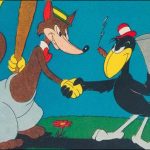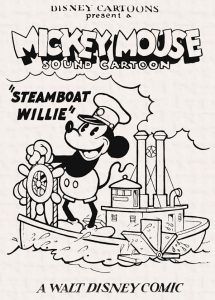


And so, another New Year kicks off, and we sort through another list of resolutions that we hope will last until Valentine’s Day. We also consider new beginnings, which is why, from an animation standpoint, it’s the perfect time to look back at where some of the most popular characters in the medium got their start.
Continuing a tradition that began a few years ago (for other “In the Beginning” articles, click here: 2021, 2022, 2024), here is a look at the debut films of some classic animated characters:
Steamboat Willie (1928) – Minnie Mouse
Along with Mickey Mouse, Minnie Mouse debuted in this first synchronized sound short subject from Walt Disney, which debuted on November 18th, 1928.
 In later cartoons such as The Nifty Nineties (1941) and Mickey’s Birthday Party (1942), Minnie would be Mickey’s steady girlfriend. Here, their first short subject is almost an “origin story” of their meeting. Mickey, working on a steamboat under the watchful eye of the villainous Pete, stops by a dock to pick up supplies. When a passenger, Minnie, is running by onshore looking to board, Mickey literally picks her up, using a crane to hoist her onto the boat.
In later cartoons such as The Nifty Nineties (1941) and Mickey’s Birthday Party (1942), Minnie would be Mickey’s steady girlfriend. Here, their first short subject is almost an “origin story” of their meeting. Mickey, working on a steamboat under the watchful eye of the villainous Pete, stops by a dock to pick up supplies. When a passenger, Minnie, is running by onshore looking to board, Mickey literally picks her up, using a crane to hoist her onto the boat.
Once on board, Minnie helps Mickey with his “Turkey In the Straw” performance, in which Mickey cruelly flings a cat (a catapult, quite literally) and pulls on a duck‘s neck to make music. Minnie assists by cranking the tail of a goat who has eaten the sheet music for “Turkey In the Straw.”
Like Mickey, Minnie’s look in her debut is much different from how audiences know her today and one that would evolve through the years. Reflecting the rubber hose style of animation prevalent at the time, in Steamboat Willie, Minnie is almost a mirror reflection of Mickey, except she wears a skirt, top, high heel shoes, and a hat with a flower sticking out the top.
Minnie isn’t the “damsel in distress” that she would be in later shorts, such as 1932’s The Klondike Kid, but instead takes an active role in Steamboat Willie. Thanks to legendary animator Ub Iwerks, what is also accomplished here is the establishment of one of animation’s most famous relationships between two characters that continues to this day.
 The Fox and the Grapes, (1941) – Fox & Crow
The Fox and the Grapes, (1941) – Fox & Crow
This constantly dueling duo, stars of Columbia Pictures shorts, debuted in a 1941 cartoon directed by another industry legend, Frank Tashlin.
Inspired by the Aesop fable, the cartoon short opens with the Fox happily skipping through the woods with his picnic basket, looking for a perfect picnic place. He’s soon spotted by the antagonistic Crow, who has eyes on the picnic basket. The Crow places out signs to entice the Fox: “The Garden of Eat In,” “A-Tisket, A-Tasket, Park Your Yellow Basket,” etc.
The Crow attempts to get a hold of the Fox’s food, but the Fox thwarts his attempts. The Crow reads that the fox likes grapes and uses that as bait.
 The Fox then attempts different methods to jump to the branch where the Crow had attached the grapes. Each time the fox fails, the Crow sits cooly by, watching. The Crow marks each attempt with a pencil mark on the tree. Toward the end of the short, we see that the Crow has to sharpen his pencil and that the tree is covered in marks.
The Fox then attempts different methods to jump to the branch where the Crow had attached the grapes. Each time the fox fails, the Crow sits cooly by, watching. The Crow marks each attempt with a pencil mark on the tree. Toward the end of the short, we see that the Crow has to sharpen his pencil and that the tree is covered in marks.
The exhausted Fox finally attempts a trade, but the sneaky Crow keeps the picnic feast and the grapes. The Fox then ties himself to a rocket, decimates the tree, and discovers that the grapes he finally gets are sour.
The Fox and the Crow would go on to be featured in a number of short subjects, and their continued hostile relationship is set up perfectly in this first cartoon. Thanks to the talent of Tashlin (with vocal delivery by the iconic Mel Blanc), The Fox and the Grapes is peppered with moments of sharp humor (the Crow reads in a book entitled “Eslop’s Fables,” where it states: “Foxes are suckers for grapes…especially in gorgeous Technicolor!”).
Mel Blanc signed his exclusive deal with Warner Bros. after finishing this film. Frank Graham took over the voices for both characters afterward for Screen Gems and did a fabulous job. The character’s later design remained similar to that in The Fox and the Grapes, even when they transitioned to being produced by UPA Animation Studio.
While the Fox and the Crow aren’t as well remembered as many other animated characters of the time – despite a DC Comic book that lasted over 20 years – their debut here and many of their other shorts are classic, back-and-forth cartoon character battles. Another legend, Chuck Jones, has noted that the Fox and the Crow were an inspiration for two of Warner Bros. most famous characters…
Fast and Furry-ous, (1949) – Wile E. Coyote and the Road Runner
 Watching The Fox and Grapes and Fast and Furry-ous back-to-back, it’s easy to see where Jones got his inspiration. Like the Fox and the Crow, this debut of the Road Runner and Wile E. Coyote is a series of set pieces where the Coyote attempts to catch the Road Runner, each separated by a fade-to-black.
Watching The Fox and Grapes and Fast and Furry-ous back-to-back, it’s easy to see where Jones got his inspiration. Like the Fox and the Crow, this debut of the Road Runner and Wile E. Coyote is a series of set pieces where the Coyote attempts to catch the Road Runner, each separated by a fade-to-black.
In Fast and Furry-ous, it is interesting to see that the design for Wile E. Coyote and the Road Runner hasn’t changed tremendously over the years. Additionally, so many of the trademarks that would become part of their future cartoons are seen here right from the beginning: the Road Runner’s “Beep! Beep!,” the Coyote tying himself to a rocket, the fake painted tunnel in the side of the cliff that proves to be a portal only for the Road Runner, and a box from the Acme Company (this time a superhero suit).
Thanks to the genius of Jones and writer Mike Maltese, there’s also brilliant use of the absence of dialogue and another trademark, where the characters hold up signs to express themselves. When the Road Runner runs over the Coyote after he has created a fake school crossing, the bird holds up a sign that states: “Road Runners Can’t Read.”
Jones and his team of artists – Ken, Harris, Phil Monroe, Ben Washam, and Lloyd Vaughn – also brilliantly use space and perspective in Fast and Furry-ous, as they did in future shorts, particularly a sequence taking place on a highway cloverleaf, where the characters are portrayed as moving dots.
This first appearance of Road Runner and Wile E. Coyote makes it easy to see how they became one of animation’s most famous ongoing pursuits.
And so, as we all start this year anew, wondering where the next twelve months will take us, watching these debut cartoon shorts is a nice reminder that everyone starts somewhere.